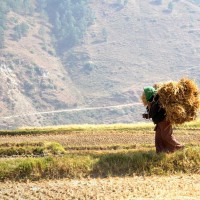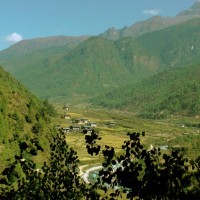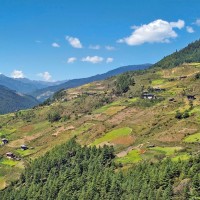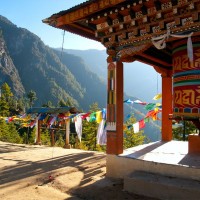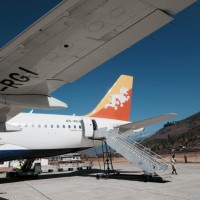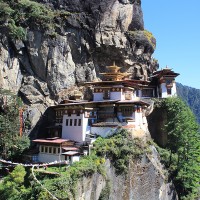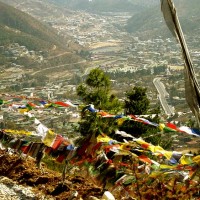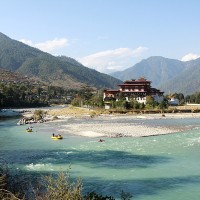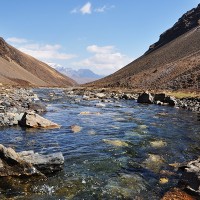Bhutan Trekking Information
Overview
Trekking in Bhutan allows you to explore Bhutan’s incredible beauty, clean air, unspoiled and un-crowded trails that offer trekker an exhilarating and memorable experience. Trekking in Bhutan is an unforgettable experience – a journey to a remote land often far from civilization, a journey of cultural exchange, a journey back in time, a journey of discovery about others and about one’s self; above all it is a complete and unique experience which satisfies adventurous ambitions and provides inner fulfilment.The power and beauty of the mountains is more impressive on foot than from any vehicle. In Bhutan, be it a long or short trek, the views, villages, people and experience will be unparalleled.
You walk with a daypack, typically containing your camera, water bottle and small personal items. Pack animals will transport the rest of the equipment, along with camping gear and food. Excellent and nutritious meals are prepared by experienced cooks and are served in enclosed dining tent with tables and camp stools. Our private guides lead the way, explaining the sites and traditions and natural history of the area. Local staff handles all the camp chores.
Note that all treks in Bhutan are by camping, there are no lodge trekking available in Bhutan.
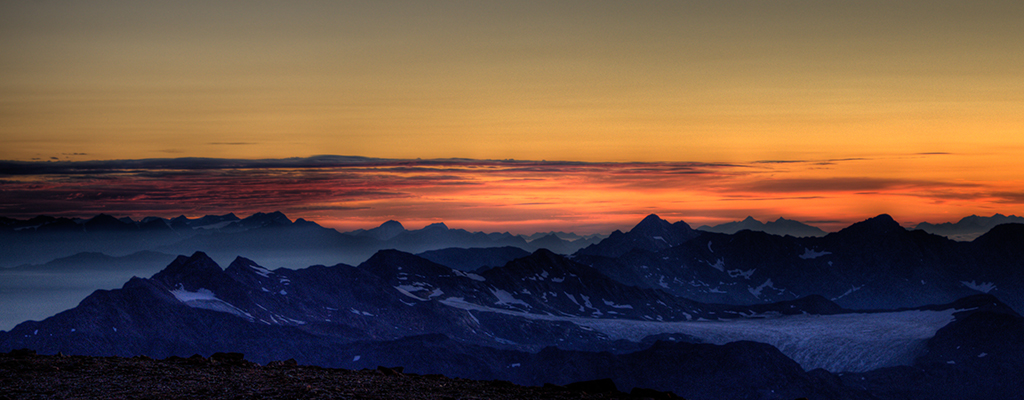
A Typical Day in the Trek
At dawn, the Bhutanese trek crew wakes you up and offer a cup of warm tea with a smile. After freshening and finishing the tea, you will have hearty breakfast, pack your bags and set off on the day’s trek. After approximately 2-3 hours of trekking the group take a break for lunch somewhere in the trail. The crew will prepare fresh lunch. After a relaxing lunch, you will typically spend around 2-3 hours or even more sometimes on the trail before reaching the next rest point. Throughout the day, you will take frequent rest breaks and take time to admire the fascinating mountains views. You can take plenty of pictures of incredibly panoramic mountains, rivers, landscapes, prayer flags, temples, shrines, and monasteries. Once you arrive at the campsite have a brief rest and have a light snack with tea or coffee. Where possible, you may take a short walk around the vinicity. After setting up the camping tents, you can do your dry cleaning, have time to read or chat with fellow trekkers or with the crew. A toilet tent will also be set up for your use. Following a warm dinner in a cozy dining tent your chief guide briefs you on the next day’s journey. Extra time can be spent on reading, enjoying some drinks or playing cards. Finally, it is off to bed for a well-earned night’s rest before starting all over again the next day.
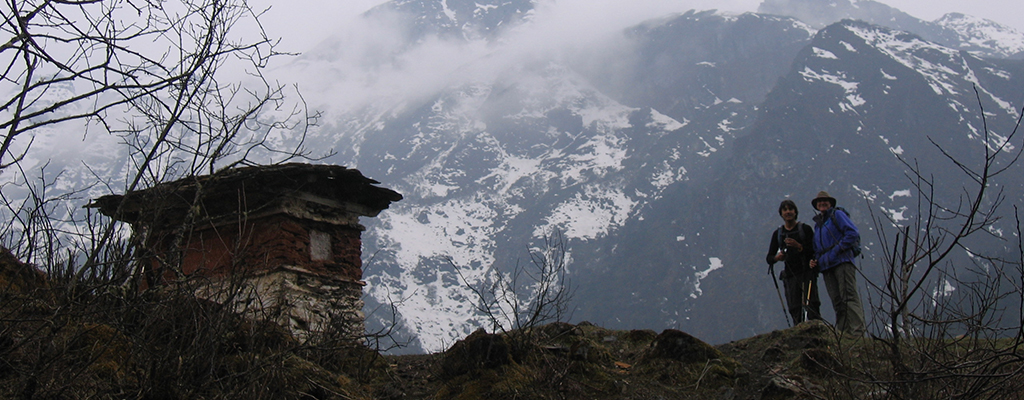
What You Need to Know
Health and Experience Requirements
At Divine International, our treks are suitable for passionate walkers who have the ability to walk at least 6 to 8 hours a day with a light daypack. Walking in higher altitudes is more physically demanding than walking in the lower altitudes; however, if we are in excellent health with average physical fitness, have a positive attitude, self-confidence and strong determination, we can accomplish the trek successfully. Exercising and jogging regularly for some weeks prior to the trip is good idea to enhance our strength and stability. Past hiking experience would be an asset but generally no technical skill is required.
Medical Condition
If you have special medical condition, it is good to check with your family doctor if you are fit enough to trek. If you are declared unfit to trek, we would advise you against trekking as it will not be worth taking the risk and most times evacuation can be costly. Participants with pre-existing medical conditions such as heart, lung, and blood diseases should inform Divine International before booking the trek.
Travel Insurance
It is mandatory that all clients be insured for expenses that may incur due to medical issues or accidents (this includes evacuation by air ambulance, helicopter rescue, and treatment costs). Please note that Divine International do not arrange for insurance.
Acclimatization
Divine International’s itineraries include one or two night stay in Paro or Thimpu before the trek as a way to acclimatize.
Trek Grading
Grading is a term used for rating treks based on difficulty. According to Divine International Trekking standards and experience, treks are divided into four types- Easy, Moderate, Challenging. The challenge in terms of both technicality and geography increases as we move higher in that order. Thus, Easy and Moderate treks could be suitable for all while Challenging treks are meant only for those who already have a certain number of experiences in trekking. Furthermore, Grading will help you choose trekking and climbing that best suits your fitness level and experience. Please keep in mind that this is only a general guide. A variety of factors, including weather may add to the challenge.

Trekking Arrangement
Trekking Crew
Trekking in Bhutan is very comfortable as compared to other places. Each trek arrangement includes guides, porters and cooks who handles the logistical aspects of the trek. The most significant thing that makes our treks successful, enjoyable and memorable is the skilled, experienced, courteous and helpful trek leader and the crew members with ability of operating our days in the mountain smoothly. Our trek will be led by the best and most professional leaders.
Responsibilities of each crew member:
Chief guide: shows you the way and makes decisions with regards to safety and accommodation.
Assistant guide (8 pax onwards): assist the Chief guide to manage the trekkers’ needs. For bigger groups he usually helps out the slower member(s) in the team, or set up campsite ahead of arrival.
Porterage by yaks: A yak carries your big backpack while you carry your small daypack.
Cooking Team: they come with camping treks to satisfy your tummies with their professional cooking skills.
Tents
Sleeping – You sleep in good quality tents which help keeps you from the cold.
Toilet – Toilet tent is set up separately for male and female. You cover with soil after your business. Toilet paper is provided.
Dining – All meals will be taken in the cozy dining tent.
Shower
There is no shower facilities during trek. You need to bring towel and powder for self dry-cleaning.
Meals
All meals will be prepared by the cooking team. A glimpse of what you may get: bread, hot beverage, rice, noodle, egg, sardine, tuna, luncheon meat, potato, range of vegetables, pancake, pasta, cookies, bread etc.
Drinking Water
The cooking team will boil water during lunch and dinner daily for your consumption.
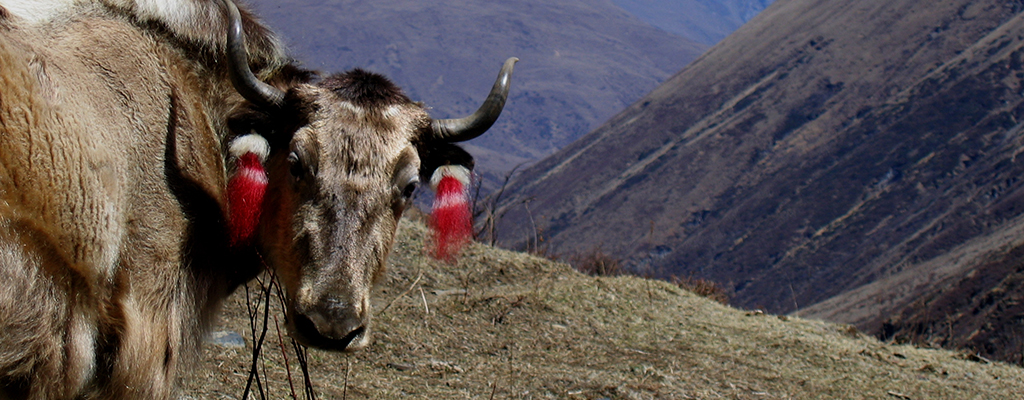
Trekking FAQ
What is the best season for trekking?
The best time for trekking is in the pre-monsoon springtime (March, April, May) and the post-monsoon fall (September, October, November). However, if you wish to avoid the crowd in these seasons and prioritize clear sky and view of the wide variety of flora and fauna we can make arrangements. However, winter (December, January, February) is colder and in summer/monsoon (June, July, August) rain might be an issue.
What kind of weather can I expect during trekking? How cold does it get?
Weather in the mountains is notoriously difficult to predict. Nights are generally colder than the days. Winter (December, January, February) will be colder but the days will be beautiful with clear sky. A bit of snowfall can be predicted in January, February and December. It is also important to make sure that you stay warm and dry in just about any weather conditions.
| Average Temperatures in Bhutan (in Degree Celsius) | |||||||||
| Altitude | Jan | Feb | Mar | Apr | May | Sep | Oct | Nov | Dec |
| 2200m Paro | 2-18 | 2-15 | 4-20 | 10-25 | 12-25 | 14-25 | 11-22 | 8-20 | 5-15 |
| 3000m | 0-12 | 0-14 | 2-15 | 5-20 | 8-25 | 10-19 | 6-20 | 1-15 | 0-13 |
| 4000m | -4-10 | -5-10 | -2-13 | -1-15 | 0-16 | 1-17 | 0-12 | -2-12 | -4-10 |
| 5000m | -7-5 | -7-5 | -5-7 | -3-11 | -1-12 | -1-12 | -3-10 | -4-8 | -5-6 |
Do I need to bring additional medicine for the trekking?
We suggest you to carry simple medicines for yourself such as Panadol, Strepsils, anti diarrhea tablets, medicated oil etc. Please also include medication specific to your own needs and on doctor’s advice.
What kind of clothes do we require for the trekking and is it possible to purchase it in Paro before the start of the trip?
What you want to wear depends on you. A down jacket, thermal longs and top, comfortable trekking trousers, t-shirts, fleece, windproof jacket, hat, scarf, and5 gloves might be useful. Please prepare all the necessary trekking apparel you need before trip as it concerns size and comfort. You will not have time to purchase anything in Paro and they have very limited trekking ware.
Do I need to bring any bags for trekking? If yes, what kind?
During trekking, you will be on a long journey for which you will need two bags to keep your belongings. A backpack/duffle bag and a day bag for personal items. While the duffle bag will be carried by yaks, you will have to carry a day bag on your own. A day bag is a small backpack that has enough room for everything you will need on a day hike such as water, extra clothing and perhaps a few personnel items like wallet, camera, battery chargers etc.
Do I need to bring any personal equipment like sleeping bags, down jackets, walking poles etc.?
Divine International will provide each trekker with a sleeping bag with fleece inner line (up to – 8 degrees). Trekking poles are not essential though and the walk is manageable without them. It is mostly a personal preference. You will probably find them useful especially on the way down. Please bring your own trekking poles if you prefer to take them with you on the trekking.
Can I take a suitcase?
You can bring a suitcase with you together with your backpack and day pack. You can leave it at a hotel in Paro or Thimpu and bring along your backpack and daypack for the trekking. Your backpack must be less than 15kg. Remember, travelling light is much less of a hassle, so do not bring things you can do without.
Is it possible for me to store extra clothing that I will not need?
Yes, if you have a bag of extra clothing for when you return from the trekking, you will be able to store it at the hotel in Paro or Thimpu.
What problems can arise on high altitude? What are the solutions?
It is possible to be stuck by AMS (Acute Mountain Sickness) which on high altitude above 3500m. To counter this symptom, drink lots of water, stay active and take proper meal while on trek.
What happens if I am no longer able to continue trekking? What happens if I need to leave early?
Our guides will make required efforts to obtain the necessary transportation and reservations to get you home as quickly as possible if for any reason you need to depart early. However, you will not be entitled to any refund for the services (such as: hotel, transport, flight, etc.) included in the package that you would not use later.
Are there any communication facilities available while we are on the mountain?
Mobile Phone services are available throughout Bhutan and maybe on trek routes but the quality of the reception vary from location to location. Internet facilities can be found only in the city. However, these facilities can be expensive. Our guides will carry mobile phones which also can be used by you when/if necessary.
Will I be able to charge my batteries during trekking?
No. Please bring extra batteries.
Should I tip the trekking and tour crew?
Tips are not mandatory. However, if you wish to tip to show your gratitude, it will be welcomed. Tipping can be in Bhutanese Ngultrum. Upon arrival in Paro, you can change some amount for small tips to trekking crew, tour guide and driver, etc. The tip amount is entirely up to the client.
What is the main language spoken?
All guides can speak good English.
Can I bring comfort food?
Yes, feel free to bring along snack bars or light canned food or biscuits for the trek, keeping in mind the weight of your bag.
How do I keep myself warm during trek?
It is important to bring enough warm clothing, a good jacket with fleece inner lining and downjacket for high altitude treks.
Can I do laundry during trek?
No.
Pace of Trek
On the average you trek 6-8 hours each day and break for lunch.
Are there any additional expenses on the trek?
No.
Packing List
Click here for a general guideline of what to pack for a trekking trip.


